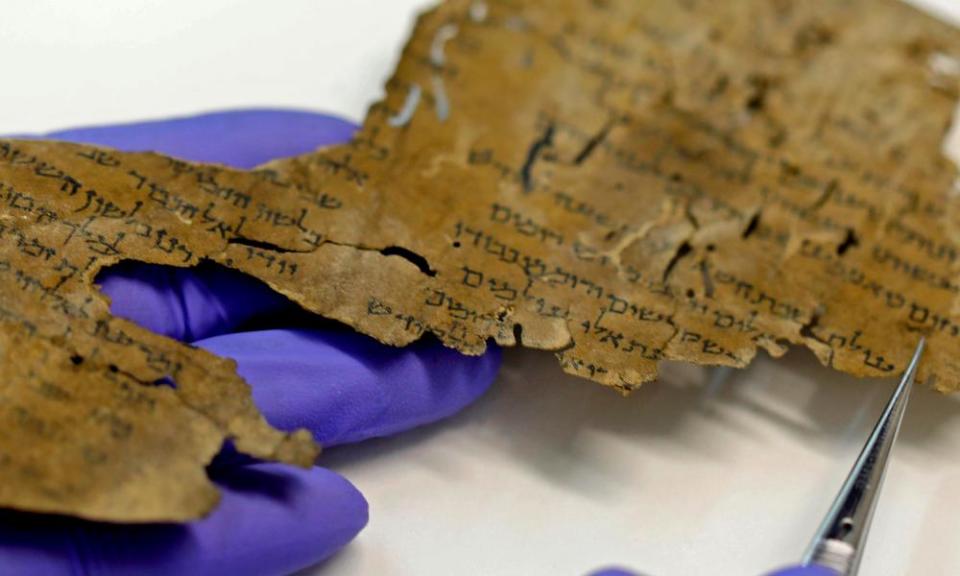Ancient DNA is offering clues to puzzle of Dead Sea scrolls, say experts

With myriad fragments and an extraordinary past, the Dead Sea scrolls are quite a puzzle. Now experts say ancient DNA has helped them piece together which fragments come from the same scrolls, as well as which texts may have travelled a distance, and how widespread the writings were.
The scrolls are one of the most remarkable discoveries of the 20th century. Found in the caves of Qumran as well as other sites around the Judean desert, the ancient texts cover parts of the Hebrew bible canon as well as writings about religious practices, legal documents, and hymns.
However, while nearly complete parchment scrolls have been discovered, there are also a multitude of fragments – more than 25,000 in total – some of which have a debated origin.
“For the first scholars they faced a formidable task of trying to understand how many jigsaw puzzles they are actually having, and how many of an unknown number of pieces was lost forever,” said Prof Noam Mizrahi of Tel Aviv University, Israel, and a co-author of the research.
Now researchers say ancient DNA is offering clues.

“The biological material of the texts, that the texts are written on, is as informative and as telling as the text that was written on it,” Mizrahi told the Guardian.
Writing in the journal Cell, the team reported how mitochondrial DNA extracted from 26 fragments reveal that 24 of them, including two fragments from the book of Jeremiah, were made of sheep skin, while two fragments, also of Jeremiah, were made from cow skin.
That suggested the latter were probably produced outside of Qumran, the team said. “The Judean desert has not been well suited for cow husbandry for at least the last two millennia, and there is no evidence for the processing of cow skins in Qumran.”
The researchers added that the idea was supported by other evidence, including that one of the cow-skin fragments was thought to date to long before the scrolls were left in the caves at Qumran.
What is more, with each of the cow fragments showing a different version of Jeremiah, the team said the results suggested different versions of the text were circulating in the region, and were not just down to the scribes of the Qumran sect who, Mizrahi said, had a “peculiar world view”.
Similarly, the team say genetic analysis of fragments bearing the non-biblical Songs of the Sabbath Sacrifice, suggests this text, too, was circulating beyond Qumran.
The researchers further analysed the 24 sheep fragments, as well as other items found in the caves, by looking at nuclear DNA.
While this DNA was highly degraded, and contaminated with human DNA, the team said they were still able to explore genetic similarities and differences.

Among their results, the team found a fragment of a legal document allegedly from cave 4 in Qumran did not cluster genetically with other Qumran fragments – supporting suspicions from previous research that it had a different origin. The technique also revealed to which of two ancient waterskins, each made from a whole sheep and found in the same Qumran cave, a broken-off leather fragment belonged, and revealed scroll fragments written in a particular scribal tradition called QSP cluster together genetically, suggesting they came from a small area in contrast to those written in other traditions.
But Prof Ira Rabin, an expert in the Dead Sea scrolls from the Federal Institute for Materials Research and Testing (BAM) in Germany, said the research did not reveal any new details, while it has long been known that some of the scrolls come from outside Qumran.
“[Generally] one does not need DNA to see whether a fragment is from a cow or from a sheep,” she added, also pointing out previous genetic studies found no sign of sheep skin – something the authors of the new study say is down to the limitations of early ancient DNA techniques and different fragments being studied.
However Dr Matthew Collins, a senior lecturer in Hebrew bible and Second Temple Judaism at the University of Chester, welcomed the research.
“By examining genetic relationships between different scrolls – and thus between the animals whose skins were used to produce them – it may be possible to identify whether clusters of texts originated in a single flock, or family, of animals – which may indicate a more focused or localised origin – or whether there is instead relatively little genetic correspondence between them, which may suggest a far more diverse origin, being imported from elsewhere,” he said.
But he added: “It’s important to remember that this DNA sequencing only tells us about the origins of the parchment, not where the scrolls themselves were written.”


